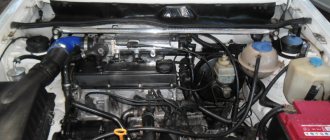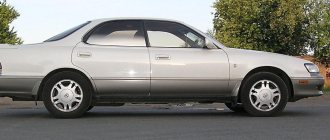Toyota Estima, Estima Emina, Estima Lucida are the names of Japanese minivans from Toyota. The cars are very interesting and practical. It is extremely unfortunate that not all worthy models of Japanese manufacturers reach the European market, in particular Russia. This is exactly the situation observed with these three above-mentioned models.
Of course, it is possible to buy such a car in Russia and it is not even difficult to do so, but these will be right-hand drive cars imported into our country. But despite the right-hand drive, in Russia Estima, Estima Emin and Estima Lucida are in demand. It is worth considering these models in more detail in order to form a full-fledged opinion about them.
The base model is the Toyota Estima, while the other two are an attempt by the manufacturer to please the consumer in the domestic market, the thing is that in Japan the classic Toyota Estima did not take root precisely because it was bulky, but in the rest of the world a large minivan from Toyota appreciated.
Toyota Estima Lucida 1993
Toyota Estima Lucida 1st generation
The world learned about this car in 1992, which was already far away for us. The car seats up to eight passengers, and on the side of its body there is a sliding door into the passenger compartment of the cabin. This car model was equipped with two engines. One of them was gasoline, and the second was diesel. The model could be with all-wheel drive or with only a driven rear axle.
The choice of car configurations is very wide.
3C-TE (3C-T) is a diesel engine with a displacement of 2.2 liters and capable of producing 100 horsepower. This motor was also found on other Toyota models:
- Estima Emina;
- Caldina;
- Carina;
- Corona Premium;
- Gaia;
- Ipsum;
- Lite Ace Noah;
- Picnic;
- Town Ace Noah;
- Camry;
- Toyota Lite Ace;
- Toyota Vista.
This engine was a four-cylinder, in-line, equipped with a turbine. According to the passport, it consumed about 6 liters of diesel fuel per 100 kilometers; in fact, when fully loaded, it was more.
Engine Toyota Estima Lucida 2TZ-FE
The 2TZ-FE engine is a gasoline power unit. Its rated power is 135 hp, with a displacement of 2.4 liters. This is an inline four-cylinder engine. The declared consumption was about 8 liters/100 kilometers. This is the same power unit that was installed on the classic Estima and Estima Emina.
Salon and layout
A huge advantage of the Toyota Estima minivan, undoubtedly, was the interior, which was supposed to provide comfort to a large family in various situations that could arise during even the longest journeys. Two interior options were provided: for seven and eight passengers, respectively. Regardless of the chosen seating option, the driver and front passenger “looked” in the direction of travel, but the second row of seats was turned in the opposite direction.
In addition, in the middle row the seats were separated from each other and consisted of two parts: for two and one passenger. This arrangement provided for changing the configuration of the free space in the car interior. It was possible to fold one seat and turn the interior of the Toyota Estima car, the photo of which is presented above, into a dining area with a “banquette” table. The third row of seats included two full-fledged chairs with armrests in the seven-seat version. With an eight-seat layout, the rear row of seats was identical to the middle one. In this case, in any case, it was possible to fold all the seats and get a berth for the entire cabin, without touching the trunk space.
Second restyling of Toyota Estima Lucida 1st generation
The car was sold from 1996 to 1999; the model was later discontinued. The changes to the body are noticeable, especially in the front part, where the optics were located, and the interior has also been well-designed. On the new model, the 3C-TE engine has become 5 horsepower (105 hp) more powerful, this was achieved through alternative tuning and firmware. The 2TZ-FE petrol engine remains unchanged.
Toyota Estima Lucida 1997
Second restyling of Toyota Estima Emina 1st generation
This version of the car was sold in Japan from 1996 to 1999. The model has become more modern. We worked on both the design of the body and the interior of the car. Among the engines, they installed the diesel 3C-TE with a power increase of up to 105 “horses” and the proven gasoline 2TZ-FE. In the last year of production there was a drop in sales, probably for this reason the manufacturer discontinued the model, concentrating on the classic Estima.
Toyota Estima Emina
Toyota Estima 1st generation
This is an eight-seat minivan that is still around today, experiencing one update after another. The history of the model dates back to 1990. At one time, the car was a kind of revolution in the global automotive industry. There were many configurations and versions of this model. It was offered in both rear-wheel drive and all-wheel drive.
Under the hood, this car could have the 2TZ-FE, which we already looked at. The manufacturer also offered another gasoline power unit - a 2.4 liter and 160 horsepower 2TZ-FZE. This engine was installed only on this car (pre-styling and restyling of the first generation).
Reviews for the Toyota Estima engine
Here's what car owners write about Estima engines:
- V Ishnyakov Alexander, 28 years old, Kursk. I bought myself a Toyota minivan with a 1 GR FE engine. It seems this was installed on all Highlander-type jeeps. Completely satisfied. The engine just purrs under the hood and it's a pleasure to drive. Oil and fuel consumption is normal. Although they tell me that this usually happens when the car is new. There is only one problem in winter: it is difficult to start the car. I’m going to go to a car service center, let them see what’s wrong;
- Chelnets Alexander, 40 years old, Moscow. I have long dreamed of owning a minivan to go with my family on picnics outside the city. We have a big family. I bought Estima. Friends said that I would suffer with the engine. Yes, at first there were a lot of problems, since I took the car from my own hands. But having invested about 100 thousand rubles in the engine, I got some candy. The Estim engine does not make noise or buzz. It eats oil and diesel normally. It's a pleasure to drive. Copes with our off-road conditions.
This is how car owners generally speak about Toyota Estima and its engines.
Restyling Toyota Estima restyling 1st generation
This update came out in 1998. The car has been modified in accordance with the times. These were subtle changes that are difficult to notice right away if you are not a fan of the model. The line of engines was cut down and a single gasoline engine was left (2TZ-FE with a capacity of 160 “horses” and a volume of 2.4 liters). In 1999, this modification was discontinued.
Toyota Estima 1998
As you can see, Estima Emin, Estima Lucida and Estima of the first generation end their history in 1999. Moreover, Estima Emin and Estima Lucida are never produced anymore. The Estim model was also abolished at first, since its second generation was released only in 2000, as if the manufacturer spent one year pondering the feasibility of release.
Disadvantages of the 3C engine
Hereditary defects from engines and additionally (for Toyota Estima):
- The exhaust manifold is cracking;
- Oil leaks through seals;
More details about the disadvantages...
The exhaust manifold is cracking (Toyota Estima)
The disadvantage is explained by the low location of the engine as a result of poor airflow when driving. The collector overheats and when water or dirt gets in, it cracks. About the same thing happens as with the head due to a lack of antifreeze.
Oil leaks through oil seals (Toyota Estima)
The low location of the engine increases overheating engine , especially if the level of antifreeze in the cooling system is insufficient; at high temperatures, the oil liquefies and leaks through the seals.
In conclusion, we can say that the engine is still not bad, and if you buy a car, make sure there is no high mileage if you do not want to deal with repairs.
PS Dear owners of Toyotas with 3C engines! You can post your comments about 3C engines here.
Second generation Toyota Estima
As already mentioned, it came out in 2000. The model had body lines characteristic of the manufacturer and was very recognizable. A feature of the model and all subsequent ones is the hybridity of the power unit. The heart of the hybrid installation could be one of three gasoline engines. The first of them is the 2.4 liter 2AZ-FXE with 130 horsepower. This motor can be found on such Toyota models as:
- Alphard;
- Camry;
- Sai;
- Wellfire.
This is an in-line four-cylinder engine, which, according to the passport data, consumed about 7 liters of gasoline per “hundred”; in fact, the figures turned out to be a couple of liters more. The engine is naturally aspirated.
Toyota Estima 2000
2AZ-FE is another gasoline internal combustion engine, its power is 160 “horses”, and its volume is 2.4 liters, it was also installed on:
- Alphard;
- Blade;
- Camry;
- Corolla;
- Harrier;
- Highlander;
- Ipsum;
- Kluger V;
- Mark X Zio;
- Matrix;
- RAV4;
- Solara;
- Vanguard;
- Wellfire;
- Pontiac Vibe.
The engine was an inline four without a turbocharger. Fuel consumption is about 10 liters per 100 kilometers in a mixed cycle with moderate driving.
1MZ-FE is the most powerful gasoline engine in this line, its power reached 220 horsepower with a volume of 3 liters. This engine was also installed on other Toyota models, among them were:
- Alphard;
- Avalon;
- Camry;
- Estima;
- Harrier;
- Highlander;
- Kluger V;
- Mark II Wagon Qualis;
- Pronard;
- Sienna;
- Solara;
- Windom.
It was a good V-shaped six-cylinder engine. The appetites of this power unit were appropriate. It consumed at least 10 liters of fuel per 100 kilometers.
Disadvantages, breakdowns and engine problems
Thread failure on the cylinder head plagued the entire series of AZ engines. As a result, antifreeze ended up on the walls of the block. As a result, Estim's engine overheated. After such a problem, the power unit was thrown into the trash.
Another common problem with Estima engines was engine vibration at low speeds. Experienced mechanics say that this is a manufacturer's defect. If the vibration increases more and more, then the best thing the driver can do is to clean the injectors and EGR valve.
Similar article Technical characteristics of the GAZ 52 engine
Many Toyota cars begin to jerk over time when driving. The fault lies in the throttle valve area. Namely, in its blockage. Therefore, you have to clean it regularly.
Turbine versions are distinguished by the short life span of the turbine and engine. The total lifespan of turbines is about 75 thousand - 100 thousand kilometers of vehicle mileage. Therefore, experienced mechanics advise monitoring the car and especially its engine with a turbine.
For example, on engines such as the 1 GR FE, the cylinder head gasket often burns out. Overheating is not a problem for these motors, because they are specially made for SUVs.
In addition, experienced mechanics note the problem of the fuel resistor, which often occurs in Toyota Estima engines. And the noise and crackling noise coming from the engine when starting the car has become a legendary and characteristic feature of all engines of the GR FE series. In this case, experienced car owners, if the noise and crackling become unbearable, change the clutch.
Every 50 or 100 thousand kilometers the fuel pump leaks. This is also a manufacturer's fault. Although it is easily replaced during service. Therefore, it does not create any special problems for the car owner.
Toyota Estima engines have problems during cold starts at thirty degrees below zero. This malfunction or characteristic feature, depending on how you call it, haunts many car owners in the northern regions. Experienced mechanics advise replacing the mounting block if the fault becomes more and more noticeable each time.
All that can be said about the Japanese manufacturer and its brainchildren is quality and reliability. Despite some shortcomings, the problems that drivers have on Russian roads are minor ones. All Estim engines are designed to last more than half a million kilometers. They more than surpass this mark.
Similar article Technical characteristics and reviews of the 3ST engine
Third generation Toyota Estima
The car appeared in 2006, it is a stylish car with all the body lines characteristic of Toyota and the corresponding branded optics. There were three engines for this model. Two kept the old ones, but modified them, so the 2AZ-FXE engine now produced 150 horsepower. The 2AZ-FE engine was increased to 170 “horses”. The new 2GR-FE engine had a volume of 3.5 liters and produced a respectable 280 horsepower.
This engine was also found on other car models of the manufacturer; it was installed on:
- Alphard;
- Avalon;
- Blade;
- Camry;
- Harrier;
- Highlander;
- Mark X Zio;
- RAV4;
- Sienna;
- Vanguard;
- Wellfire;
- Venza
- Lexus ES350;
- Lexus RX350.
Restyling of the third generation Toyota Estima
The model was updated in 2008. The front of the car has changed, becoming more stylish, and changes have also been made to the optics and rear of the body. Work was also done on the interior. The engines have not undergone any changes; they have all been transferred here from the pre-restyling model. Second restyling of the third generation Toyota Estima
Toyota Estima 2008
Externally, the car was updated in accordance with the style of the company of that time. Now it was a recognizable model from Toyota 2012. There were also improvements in the cabin that added comfort to both the driver and passengers. In addition, new modern solutions have appeared here. The engines remain the same. Front-wheel drive and all-wheel drive models are available.
History of development and creation
The first generation of the minivan was designed back in 1987 by designers David Doyle and Tokyo Fukuichi. The car had a unique platform and mid-engine layout at that time. According to the designers, the four-cylinder in-line engine was located in an almost horizontal position at an angle of 70 degrees, lying on its side under the driver and passenger seats. The main goal of the developers was to use all kinds of non-standard experimental solutions so that in the future they could be used in new models.
Third restyling of the third generation Toyota Estima
This modification took place in 2021, such machines are still being produced. The changes can be called corporate styling; no significant changes were made. Modifications with rear axle drive and all-wheel drive are available. The most powerful one (Toyota Estima) was removed from the line of engines, the other two remained unchanged.
Toyota Estima 2016
Technical data of motors
| Engine model name | Engine displacement | Engine power | Fuel type |
| 3C-TE (3C-T) | 2.2 liters | 100 hp/105 hp | Diesel |
| 2TZ-FE | 2.4 liters | 135 hp | Petrol |
| 2TZ-FZE | 2.4 liters | 160 hp | Petrol |
| 2AZ-FXE | 2.4 liters | 130 hp/150 hp | Petrol |
| 2AZ-FE | 2.4 liters | 160 hp/170 hp | Petrol |
| 1MZ-FE | 3.0 liters | 220 hp | Petrol |
| 2GR-FE | 3.5 liters | 280 hp | Petrol |
Engine
As mentioned above, the mid-engine layout was a rather unusual solution, but it made it possible to achieve almost ideal weight distribution, thanks to which the minivan had excellent handling. One of the disadvantages of this method of installing an internal combustion engine was the difficulty of replacing it with a more powerful and, accordingly, more bulky unit. To make this possible, mechanics had to significantly change the body.
Due to the fact that the model was delivered to different parts of the world, Toyota Estima, a photo of which can be seen in the presented material, was equipped with different types of engines and drive systems. Thus, the American version was equipped only with gasoline engines paired with front-wheel drive. In Japan, it was possible to find an option with a 2.2-liter diesel engine and all-wheel drive with an All-Trac transmission.











